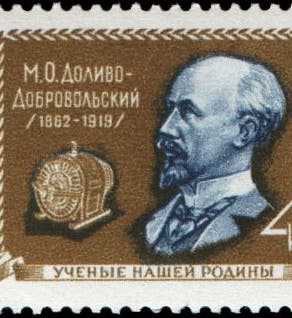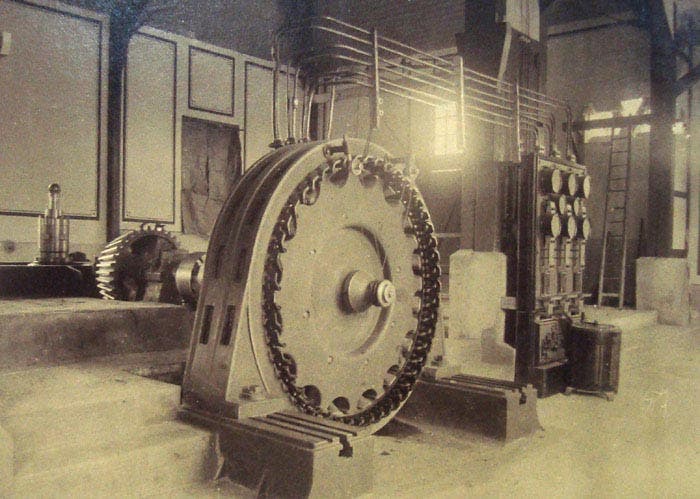Scientist of the Day - Mikhail Dolivo-Dobrovolsky
Mikhail Dolivo-Dobrovolsky, Russian electrical engineer and inventor, was born in Gatchina, a town outside of St. Petersburg, on January 2, 1862. After attending secondary school in Odessa, he matriculated at the Riga Polytechnical Institute in present-day Latvia. The Institute was one of the first technical universities in Imperial Russia, and its faculty included leading scholars from Germany, Switzerland, and Austria-Hungary. Dolivo-Dobrovolsky started training to become a chemist, but he was expelled for his progressive political views following the 1881 assassination of Tsar Alexander II.
After working for several years as a freelance lecturer, Dolivo-Dobrovolsky traveled to Germany, where a growing interest in electrochemistry inspired him to study electrical engineering at the Technische Universität Darmstadt. After graduating in 1887, he joined the staff of Allgemeine Elektrizitäts-Gesellschaft (AEG), a leading producer of electrical equipment that was poised to become a major player in the looming technical debate between proponents of direct-current (DC) and alternating-current (AC) power systems.
The so-called “War of the Currents” is often framed as a purely American conflict, with Thomas Edison advocating for the DC systems that allowed him to illuminate several blocks in New York City and George Westinghouse promoting the AC motors and generators developed by Nikola Tesla. In fact, Edison, Westinghouse, and Tesla were part of an international community of inventors, engineers, and system-builders, which included Dolivo-Dobrovolsky.
Upon learning that Tesla and Italian physicist Galileo Ferraris had independently constructed motors using a pair of alternating currents to generate a rotating magnetic field, Dolivo-Dobrovolsky wondered if he could improve upon their designs. He determined that he could significantly increase the motor’s output by using three currents rather than just two (second image). To power his new motor, he rigged up an AC generator to produce three currents operating out of phase with each other. Engineers today would describe this setup as a “three-phase” power system, though Dolivo-Dobrovolsky preferred the term, Drehstrom, derived from the German for “turning, or rotating, current.”
As Dolivo-Dobrovolsky launched his three-phase motor experiments, municipal governments across Germany were struggling to decide whether they should invest in AC or DC electrical systems. One city, Frankfurt am Main, decided to settle the question by hosting an exhibition where manufacturers could present the latest advances in electrical technology. Officials enlisted Oskar von Miller, an experienced engineer and future founder of the Deutsches Museum, to organize the event, which opened to the public in May 1891 (third image).
After consulting with colleagues at AEG and other electrical manufacturers, Von Miller decided to showcase recent advances in electrical technology through an ambitious collaboration between AEG and a Swiss firm, Maschinenfabrik Oerlikon. Engineers from the two companies converted a concrete factory in the town of Lauffen into a hydroelectric plant, using current of the Neckar river to drive a three-phase AC generator based on Dolivo-Dobrovolsky’s designs (fourth image). The resulting power would travel the full 175 kilometers (~109 miles) to Frankfurt, illustrating AC systems’ major advantage over their DC counterparts, which could only transmit power over much shorter distances.
Setting up a new power station and transmission lines took longer than originally anticipated. The exhibition opened in May 1891, but the demonstration only went live at the end of August. Everyone agreed, however, that the end result was worth the wait. Visitors to the fair marveled at a massive advertising sign containing 1,000 lightbulbs alongside a waterfall driven by an electric pump that reiterated the hydroelectric origins of the energy on display (fifth image). Beyond the spectacle, engineers were impressed to discover that 75% of the power generated in Lauffen reached Frankfurt.
The success of the Laufen-to-Frankfurt power system confirmed that AC electricity could be transmitted over long distances instead of relying on the centrally located generators that characterized earlier DC power grids. Engineers pointed to the Frankfurt exhibition as a model for future electrification projects, most notably Westinghouse’s proposal to power the city of Buffalo by harnessing Niagara Falls. Though that system initially made use of older two-phase generators, the improved efficiency of Dolivo-Dobrovolsky’s system soon made three-phase current the standard around the world.
Following his success in Frankfurt, Dolivo-Dobrovolsky was offered a position at the newly established St. Petersburg Polytechnic University. He declined the job and remained at AEG, where he led the development of a new electric railway system and later joined the company’s board. Health problems forced him to retire in May 1919, and he passed away six months later. Though overshadowed in the popular imagination by the better-known American participants in the War of the Currents, Dolivo-Dobrovolsky’s inventions left a lasting mark on the global power grid and were significant enough to merit an honorary doctorate from his alma mater (Technische Universität Darmstadt) and a Soviet postage stamp celebrating the centennial of his birth (first image).
Benjamin Gross, Vice President for Research and Scholarship, Linda Hall Library. Comments or corrections are welcome; please direct to grossb@lindahall.org.


![Figures from M. von Dolivo-Dobrowolsky, “Kraftübertragung mittels Wechelströmen von verschiedener Phase (Drehstrom)” [“Power Transmission Using Alternating Currents with Different Phases (Rotating Current)”], Elektrotechnische Zeitzschrift, vol. 12, 1891 (Linda Hall Library)](https://assets-us-01.kc-usercontent.com:443/9dd25524-761a-000d-d79f-86a5086d4774/903545ee-2d6c-469b-ab3a-f211df93b508/Dolivo-Dobrovolsky02-771x1024.jpg?w=771&h=1024&auto=format&q=75&fit=crop)







